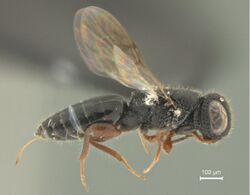Biology:Megalyridae
| Megalyridae | |
|---|---|

| |
| Cryptalyra helenae | |
| Scientific classification | |
| Domain: | Eukaryota |
| Kingdom: | Animalia |
| Phylum: | Arthropoda |
| Class: | Insecta |
| Order: | Hymenoptera |
| Superfamily: | Megalyroidea |
| Family: | Megalyridae Schletterer, 1890 |
| Genera | |
|
See text | |
Megalyroidea is a small hymenopteran superfamily of wasps that includes a single family, Megalyridae, with eight extant genera (plus around a dozen extinct ones) and 49 described species.[1] Modern megalyrids are found primarily in the southern hemisphere, though fossils have only been found in the northern hemisphere. The most abundant and species-rich megalyrid fauna is in Australia . Another peak of diversity appears to be in the relict forests of Madagascar , but most of these species are still undescribed.
Historically, there has been much confusion about the definition of this family. Species now placed in Megalyridae have in the past been classified into as many as six other families (Braconidae, Evaniidae, Ichneumonidae, and Stephanidae, as well as Dinapsidae and Maimetshidae, with Dinapsidae now considered to be within the Megalyridae.[citation needed] Maimetshidae is no longer considered closely related to Megalyridae, and has been included in Trigonaloidea with Trigonalidae.[2] The oldest fossils confidently identifiable as Megalyrids date to the Early Cretaceous.[1]
The best defining feature, unique to the family, is the mesothoracic spiracle has moved, and is actually located in the upper corner of the pronotum, though this is a fairly obscure feature to see. Perhaps the most useful visible character is that the base of the antenna fits into a wide, concave groove below the eye, though a few other wasp families exhibit this trait. Females of Megalyra have ovipositors ranging from five to eight times their body length, but this is not true of the other genera.[3]
The largest known megalyrid is the female of the Australia n Megalyra shuckardi, with a body length of 22 mm (0.9 in) and ovipositor length of 82 mm (3.2 in). The smallest known megalyrid is the Brazil ian Cryptalyra plaumanni, with a body length of 2.9 mm (0.1 in) and ovipositor 1 mm (0.0 in) long.[citation needed]
Megalyrid wasps are thought to be idiobiont endoparasitoids of concealed insect larvae. One Australian species, Megalyra troglodytes, attacks the larvae of Arpactophilus mimi, a mud-nesting crabronid wasp. Oviposition habits of Megalyridae are regarded as quite primitive, with field observations suggesting they simply poke their ovipositors into pre-existing cavities, holes, or cracks, rather than drilling into the substrate as in other Apocrita.[citation needed]
Genera
Extant genera
- Carminator East Asia, Southeast Asia, New Guinea
- Cryptalyra Northern South America
- Dinapsis Africa, Madagascar
- Ettchellsia Southeast Asia
- Megalyra Australia, New Guinea, Southeast Asia
- Megalyridea South Africa
- Neodinapsis Chile
- Rigel Chile
Extinct genera
- †Megalava Perrichot 2009 Spanish amber, Early Cretaceous (Albian)
- †Megazar Perrichot 2009 Charentese amber, Late Cretaceous (Cenomanian)
- †Valaa Perrichot 2009 Spanish amber, Early Cretaceous (Albian)
- †Prodinapsis Brues 1923 Oise amber, France, Bitterfeld amber, Germany, Rovno amber, Ukraine, Baltic amber, Eocene
References
- ↑ 1.0 1.1 VILHELMSEN, LARS; PERRICHOT, VINCENT; SHAW, SCOTT R. (October 2010). "Past and present diversity and distribution in the parasitic wasp family Megalyridae (Hymenoptera)". Systematic Entomology 35 (4): 658–677. doi:10.1111/j.1365-3113.2010.00537.x.
- ↑ Engel, Michael S. (2016-12-29). "A new genus and species of maimetshid wasps in Lebanese Early Cretaceous amber (Hymenoptera: Maimetshidae)". Novitates Paleoentomologicae (18): 1. doi:10.17161/np.v0i18.6497. ISSN 2329-5880. https://journals.ku.edu/paleoent/article/view/6497.
- ↑ Shaw, Scott Richard (1990). "Phylogeny and biogeography of the parasitoid wasp family Megalyridae (Hymenoptera)". Journal of Biogeography 17 (6): 569–581. doi:10.2307/2845141.
Cited texts
- Rasnitsyn, A.P. & Brothers, D.J. 2009. New genera and species of Maimetshidae (Hymenoptera: Stephanoidea s.l.) from the Turonian of Botswana, with comments on the status of the family. African Invertebrates 50 (1): 191–204.AbstractPDF
External links
Wikidata ☰ Q140741 entry
 |
